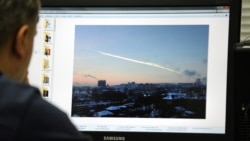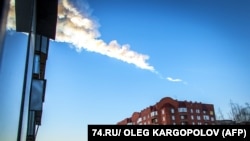The website for the city of Chelyabinsk has some decent pictures of damage from today's strike -- check them out here (text in Russian, of course).
One of the better dashcam videos out there. You can really see the burst and the arc of the meteor's trajectory:
Same building impact site from an earlier tweet. From a few feet away. #ВЗРЫВ #ЧЕЛЯБИНСК #RussianMeteor #Chelyabinsk twitter.com/CometISONnews/…
— Comet ISON (@CometISONnews) February 15, 2013
Here's a picture (click photo to enlarge) of what appears to be the same building from earlier today (via RIA Novosti):
The latest numbers from Russia are that more than 400 people have been injured -- but with mostly minor injuries. Nine have been hospitalized.
Nurislam Aybulatov, a local Tatar activist in Chebarkul [map] tells RFE/RL's Tatar-Bashkir Service:
"Around 8 in the morning we saw a huge explosion above the Chebarkul lake. It felt like an earthquake. There are military bases around and sometimes we hear the arms explosions. First we thought it was the arms explosion. There was also smell of something burnt. There is no damage or injured people in our town."
"Around 8 in the morning we saw a huge explosion above the Chebarkul lake. It felt like an earthquake. There are military bases around and sometimes we hear the arms explosions. First we thought it was the arms explosion. There was also smell of something burnt. There is no damage or injured people in our town."
Out of the many hundreds or thousands of videos from Russia, this one still sticks -- fast forward to :34 to hear the explosion.
Interfax reports that the Russian Interior Ministry syas it has found three pieces of the meteorite that crashed to the Earth in Russia. Two pieces were found in Chelyabinsk and one in nearby Zlatoust. [map]
Chelyabinsk Governor Mikhail Yurevich: "Our main task now is to preserve the heat in offices and homes where windows were shatteted, to prevent the heating system from freezing."
A couple of good resources on the location of nuclear facilities near the meteor strike in Russia.
# Here is a small map from PBS that includes a good overview of what the facilities are used for
# The FInancial Times as a Google map with pins of nuclear sites
# Greenpeace (in Russian) has a detailed map of the sites as well
# Here is a small map from PBS that includes a good overview of what the facilities are used for
# The FInancial Times as a Google map with pins of nuclear sites
# Greenpeace (in Russian) has a detailed map of the sites as well
First video we've found from a dashcam in the Qostanai region of northern Kazakhstan:







